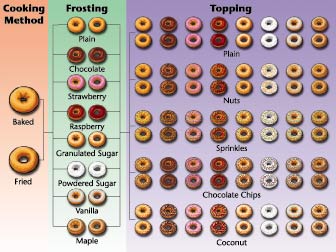SPC. Those three letters have had a major impact on my life. When I graduated from college, I thought the most
important letter was the S, for "statistical." I spent the next couple of years writing equations for an audience who was bored to death. Gradually, I realized that statistics were only a
tiny part of the problem, and I began to believe that the most important letter was the C. If we could just control things, I thought, we would never make bad parts. But that was wrong
too. Now, older and wiser (or at least older), I have come to realize that the most important letter by far is the P, for "process." Most people have trouble
understanding what a process is. They can probably grasp the abstract concept, but in their everyday work, they never think of the process. Instead, they always think of the parts.
Let me give you an example. Joe owns a doughnut shop and would like to make a better product for his customers. He starts with chocolate-frosted cake doughnuts covered
with nuts. A lot goes into this product: First, he has to make sure the chocolate isn't too hot or too cold during application. If it's too hot, it will run off, and if it's too cold, it will
clog the machine and make a mess. And the nutsódo you know how much nuts cost these days? But if Joe tries to save money by ordering stems and pieces, Mrs. Ollcut, a regular customer, will
complain. It's harder to make good chocolate-covered cake doughnuts with nuts than you might think. But Joe is determined. He makes a cardboard chart to show what temperature
the chocolate should be during application. He orders the finest nuts. He does a small-scale study on his oven and finds the best temperature to use. After a week, he asks Mrs. Ollcut to sample
his work, and she tells him that the doughnuts are even better than usual. Great! Joe is off to a fine start. Now he thinks about Mr. Lanakey from the bank. Mr. Lanakey likes
the fried doughnuts with the maple coating but no nuts. Maple coating can be tricky, and Mr. Lanakey will never accept doughnuts that are overcooked or that have too much oil left in them.
Joe makes a chart for the preparation of these doughnuts. But after two weeks of this, Joe gets discouraged. Although he has two very happy customers, there are dozens more,
each with little preferences and favorites. It will take some time for Joe to make lists of instructions for how to make every kind of doughnut he sells. In the meantime, he's letting other
important work slide while he makes his lists and charts. He makes a list of all his customers and all the different kinds of doughnuts they like. Joe gets upsetóthere are 80 different kinds of
doughnuts! At the rate he's going, this project will take almost two years. Then Joe's daughter, Chris, comes home for summer vacation from the University of Arizona, where
she's studying systems engineering. Joe explains the problem to his daughter. But, like all kids, she won't listen. She ignores his comments about chocolate and maple and goes into her room. Joe
sees her in there working on her computer, and he's sad to see that she's unwilling to help. Then Chris comes out with a picture. Great, Joe thinks; he wants to make doughnuts
and his daughter wants to make diagrams. But some of what she says makes sense. Joe takes another look at her diagram, shown in Figure 1. Figure 1: A Three-Stage Process  with 13 Elements with 13 Elements
Chris points out to her dad that he doesn't have 80 different products; he has a three-stage process composed of 13 process elements: the two cooking
methods, the eight frostings and the five toppings (2 + 8 + 5 = 13 elements). The process has 80 different paths (2 x 8 x 5 = 80), but all paths go through the same three stages.
To control this process, Joe needs to study the cooking methods, the kinds of frostings and the kinds of toppings.
Joe has already done some of this work. His concerns about the proper temperature of the chocolate and the kinds of nuts used are appropriate, but
there are 16 different products that use nuts: baked doughnuts with strawberry frosting and nuts, fried doughnuts with vanilla frosting and nuts, and so forth.
However, by breaking out the steps used to make the doughnuts, Chris has turned a daunting problem into a manageable one. Joe can now perfect his process through more in-depth study. SPC. It's neither the statistics nor the control but the process that makes improvement possible.
About the author Gregory P. Ferguson is quality manager of Parker Hannifin's Tucson, Arizona, facility. He has published technical articles and assisted in the
publication of two books. Comments can be e-mailed to him at gferguson@qualitydigest.com . |